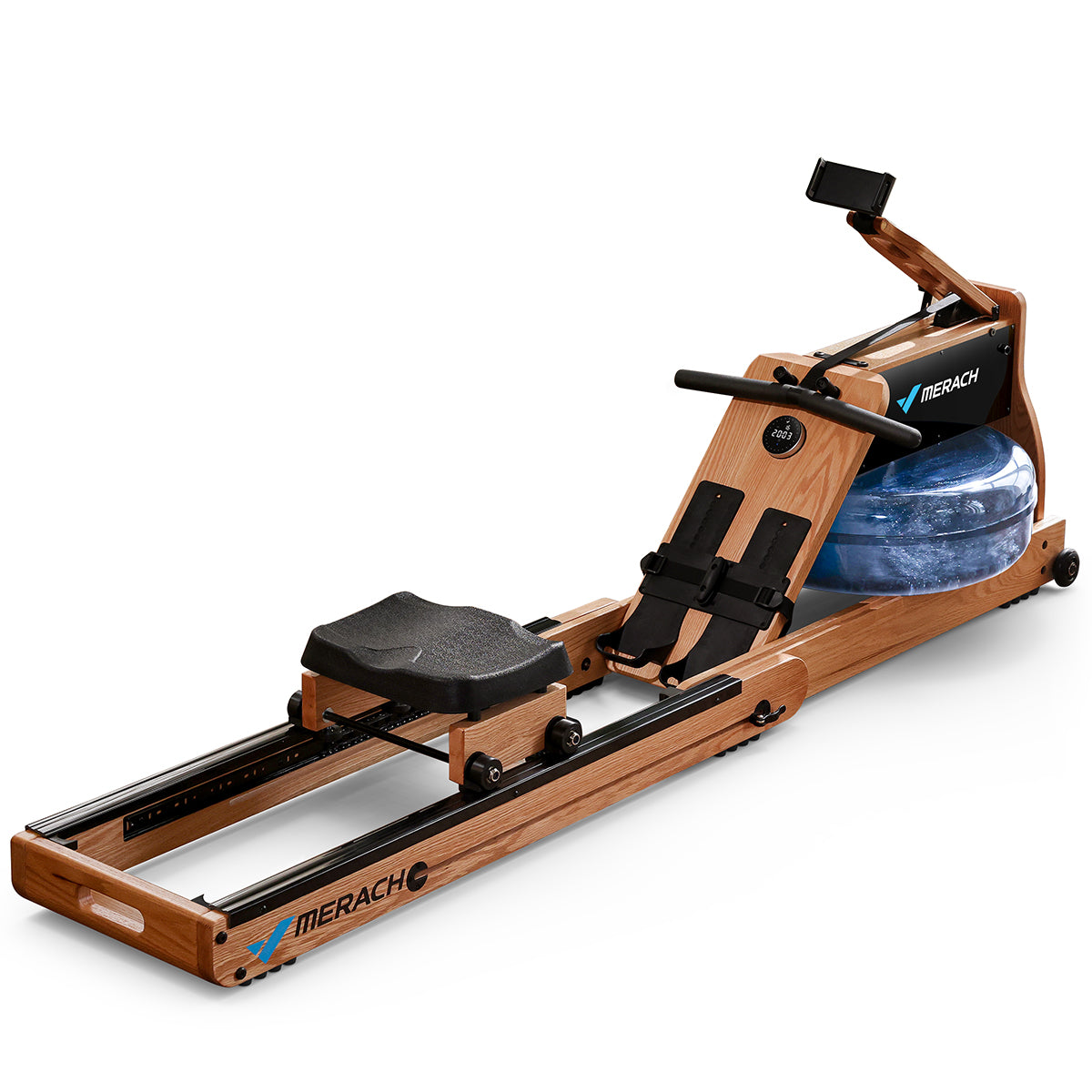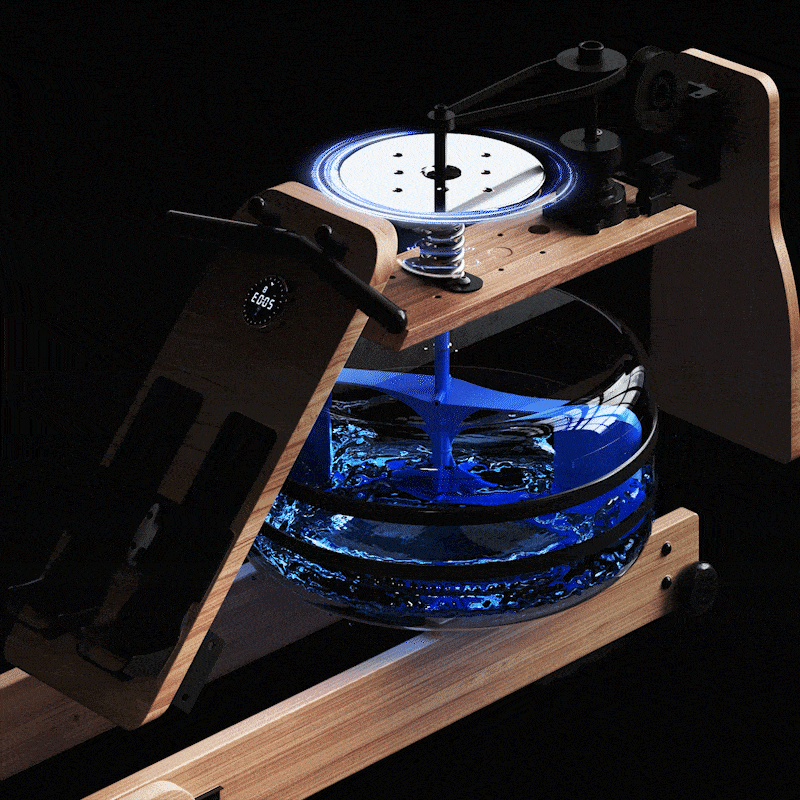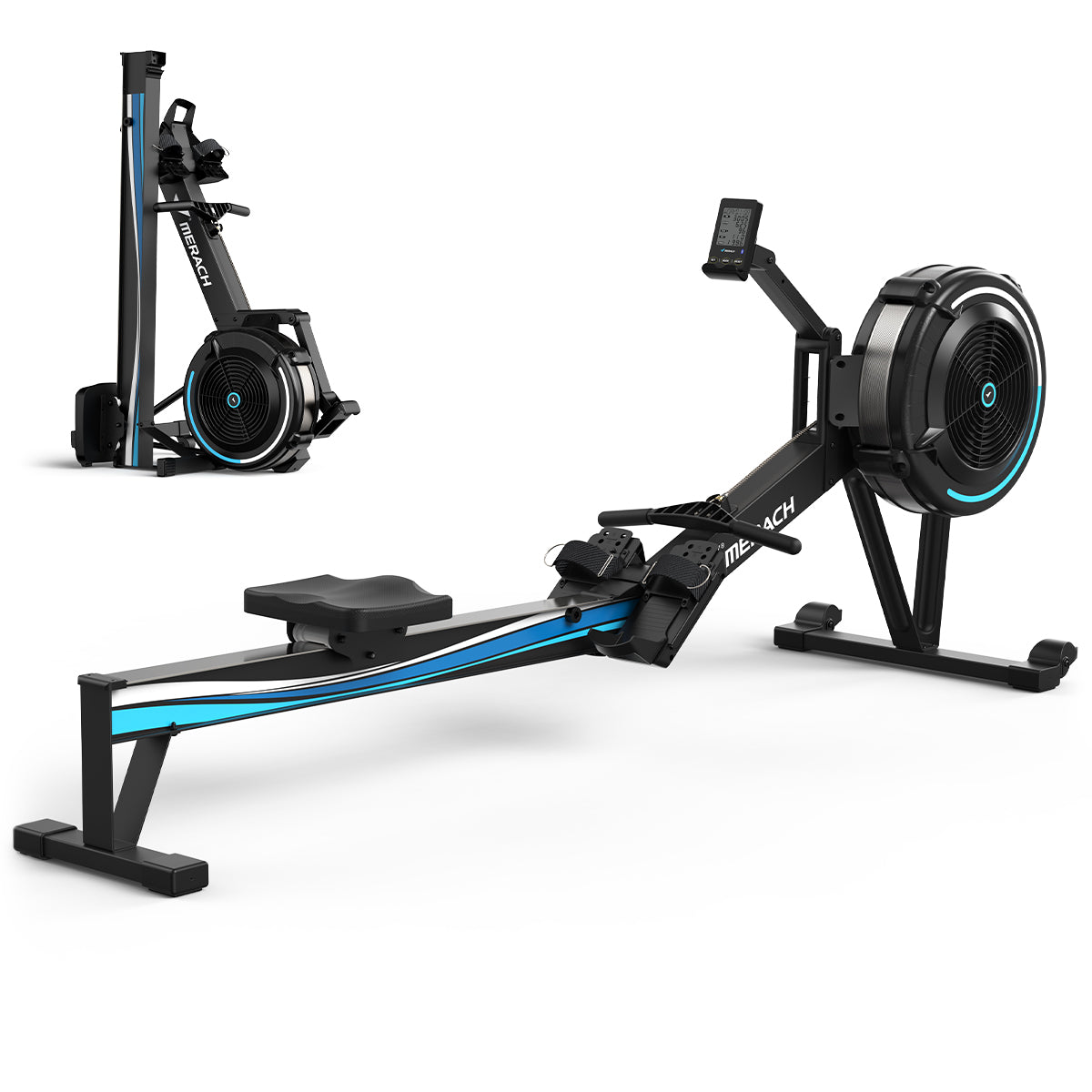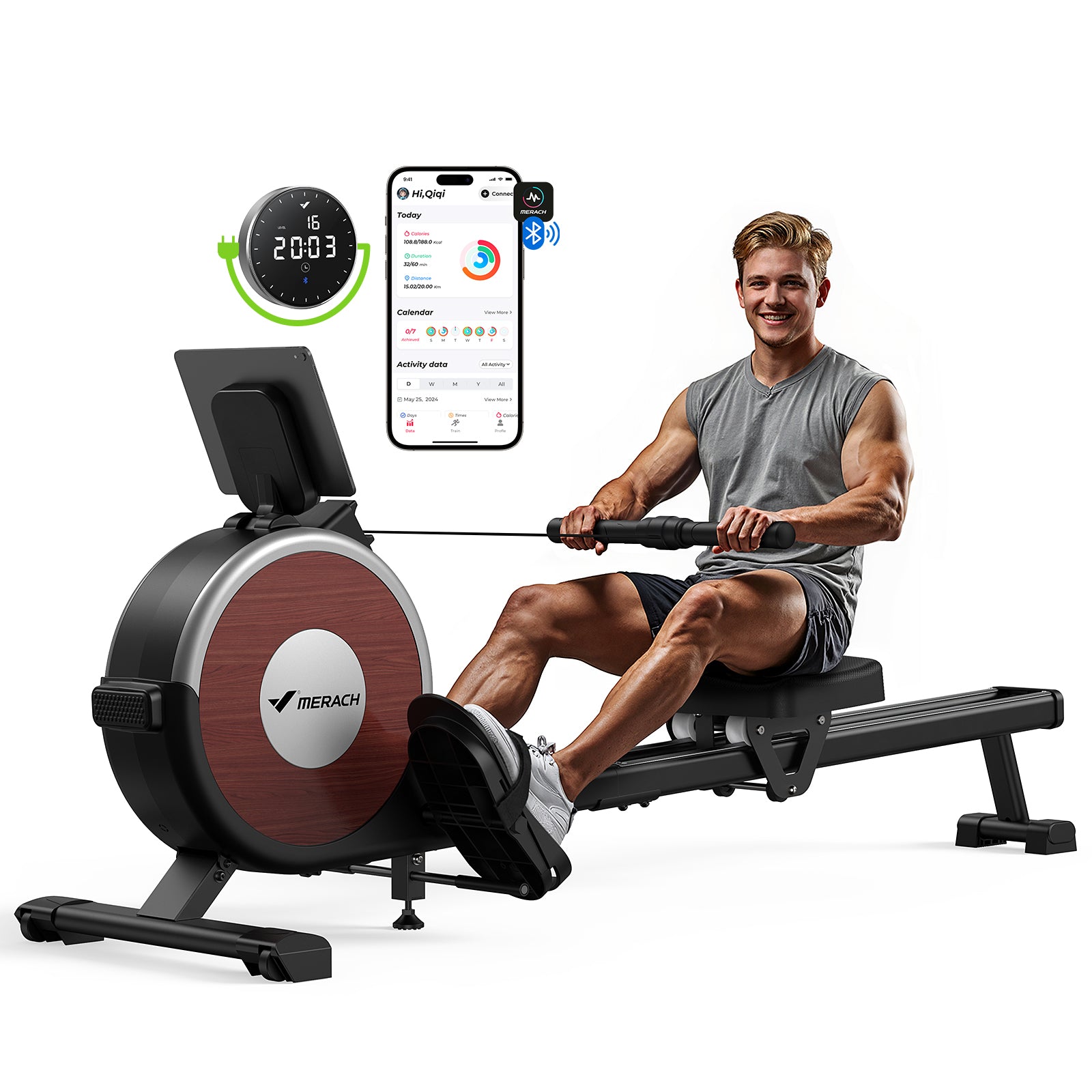A rowing machine is a great way to work out, be it an indoor rower or an outdoor rower and for good reasons. Before buying a rowing machine for home, many wonder if rowing is a good way to burn calories and lose weight. And that's the question I'm asked most frequently about rowing machines: "How many calories does rowing does rowing burn?"
The answer is both simple and complex. On average, with calories burned rowing machine exercises, you can expect to burn 400–800 calories each hour. However, it depends on several crucial factors. Understanding the nuances behind this range can help you maximize your calorie burn and achieve your weight management goals more effectively.
In this comprehensive guide, I'll break down exactly how many calories you can expect to burn on a rowing machine, the factors that influence your personal calorie expenditure, and evidence-based strategies to optimize your rowing workouts for maximum calorie burn.
1. Average Calorie Burned on Rowing Machine
Here is research that shows the fundamental data on calories burned on a rowing machine:
| Intensity Level | Calories Burned per Hour (155 lb Person) | Calories Burned per Hour (185 lb Person) | Calories Burned per Hour (215 lb Person) |
|---|---|---|---|
| Light (20-22 SPM) | 400-450 | 480-540 | 560-630 |
| Moderate (24-26 SPM) | 550-650 | 660-780 | 770-910 |
| Vigorous (28-32 SPM) | 650-800 | 780-960 | 910-1120 |
| HIIT Rowing (intervals of max effort) | 700-900 | 840-1080 | 980-1260 |
NOTE: SPM = Strokes Per Minute
These figures, compiled from research including data from the American College of Sports Medicine and our own laboratory testing at Merachfit, represent typical ranges for healthy adults. However, your personal calories burned with rowing machine may vary based on multiple factors that we'll explain in detail.
Afterburn Effect (EPOC) from Rowing
The calorie-burning benefits of rowing extend beyond the workout itself through Excess Post-exercise Oxygen Consumption (EPOC), commonly called the "afterburn effect." A study in the European Journal of Applied Physiology found that high-intensity rowing intervals elevated metabolism for up to 24 hours post-exercise, with the most significant elevation occurring in the first 12 hours. This table shows EPOC magnitude from different rowing protocols.
| Rowing Protocol | During-Exercise Calories (30 min) | Estimated EPOC Calories (24 hours) | Total Caloric Impact |
|---|---|---|---|
| Light Steady-State | 200-250 | 20-40 (10-15% of workout) | 220-290 |
| Moderate Steady-State | 275-325 | 40-65 (15-20% of workout) | 315-390 |
| HIIT Rowing | 300-400 | 60-100 (20-25% of workout) | 360-500 |
| Tabata-Style Rowing | 275-350 | 70-105 (25-30% of workout) | 345-455 |
Factors Affecting EPOC Magnitude
- Workout Intensity: Higher intensity = greater EPOC
- Duration: Longer workouts generally increase EPOC, though intensity has a greater effect
- Training Status: Less conditioned individuals typically experience greater EPOC
- Muscle Mass: More muscle tissue = enhanced EPOC effect
- Recovery Nutrition: Protein intake post-workout may slightly enhance the EPOC effect
2. Key Factors Influencing Calories Burned on a Rowing Machine
While average figures provide a useful benchmark, your personal results are determined by a combination of factors. Understanding these key variables is essential to transforming your rowing machine from a simple calorie-burner into a precision tool for fat loss.

2.1 Body Weight and Composition
Impact level: High
Body weight is one of the most significant factors affecting calorie expenditure during any exercise. Simply put, a heavier person will burn more calories than a lighter person performing the exact same workout.
According to scientific explanation, moving more mass requires more energy. For every additional 20-25 pounds of body weight, you can expect approximately a 15-20% increase in calories burned on rowing machines.
Moreover, muscle tissue is metabolically more active than fat tissue. Two people of identical weight but different body compositions (one with more muscle, one with more fat) will have different calorie expenditures, with the more muscular individual burning slightly more calories.
2.2 Workout Intensity
Impact level: Very High
Intensity is the single most controllable factor affecting your calories burned on a rowing machine. Research has demonstrated that increasing rowing intensity from moderate to vigorous can elevate calorie burn by 30-50%. High-intensity interval training (HIIT) protocols can increase caloric expenditure by up to 70% compared to steady-state rowing at light intensity.
Here are a few metrics:
- Stroke rate (SPM): Higher stroke rates generally indicate higher intensity
- Split time: Lower split times (time to row 500m) indicate higher intensity
- Watts: Higher wattage output indicates greater work being performed
- Heart rate: Higher heart rate indicates greater cardiovascular demand
2.3 Duration of Rowing Session
Impact level: High
While intensity has a greater effect on calories burned per minute, duration is linearly related to total caloric expenditure. The following shows the relationship between time spent and calories burned on a rowing machine , though the actual amount depends on intensity and body weight.
- 20 minutes: 133-300 calories
- 30 minutes: 200-450 calories
- 45 minutes: 300-675 calories
- 60 minutes: 400-900 calories
During longer rowing sessions, it's common for technique to decline slightly, which can lower your efficiency and reduce calorie burn as the workout progresses.
2.4 Technique and Efficiency
Impact level: Moderate to High
Proper rowing technique significantly impacts calorie expenditure, though in a counterintuitive way. Our Merachfit laboratory studies have found that improving rowing efficiency initially may slightly decrease per-minute calorie burn, but ultimately increases total caloric expenditure by enabling higher-intensity, longer-duration workouts.
Efficient Technique:
- Engages more major muscle groups
- Allows sustainable higher-intensity work
- Enables longer effective workout duration
Inefficient Technique:
- May actually burn more calories in the short term due to wasted energy
- Leads to earlier fatigue, reducing total workout duration
- Increases injury risk, potentially interrupting exercise consistency
2.5 Fitness Level and Rowing Experience
Impact level: Moderate
Your current fitness level and rowing experience affect calorie burn in several ways. As your body adapts to rowing, you'll need to progressively increase intensity to maintain the same caloric expenditure.
Higher Fitness Level Effects:
- Generally lower calorie burn at the same perceived exertion level
- Ability to maintain higher intensities for longer periods
- Better technique efficiency
Lower Fitness Level Effects:
- Higher calorie burn at the same absolute workload
- Limited ability to sustain high-intensity work
- Often less efficient technique
2.6 Resistance Setting
Impact level: Low to Moderate
The damper or resistance setting on your rowing machine has a more complex relationship with calorie burn than many assume. Contrary to popular belief, rowing at the highest resistance setting doesn't necessarily maximize calorie burn. Most experienced rowers find that moderate settings (3-6 on a Concept2, or equivalent on other machines) optimize caloric expenditure by balancing force production and workout sustainability.
Higher Resistance Setting (7-10):
- Requires more force per stroke
- Generally leads to lower stroke rates
- Emphasizes strength over cardiovascular demand
- May actually decrease total calorie burn in many cases
Moderate Resistance Setting (3-6):
- Balances force and stroke rate
- Allows for sustained higher intensity
- Optimizes both strength and cardiovascular demand
- Often produces optimal calorie burn
Lower Resistance Setting (1-3):
- Requires less force but allows higher stroke rates
- Emphasizes cardiovascular demand over strength
- Effective for HIIT protocols
2.7 Age and Gender
Impact level: Moderate
Physiological differences between ages and genders affect baseline metabolic rate and muscle mass, influencing calories burned with rowing machine.
At the same body weight, men typically burn approximately 10-15% more calories than women during rowing. Similarly, younger individuals typically burn more calories than older individuals of the same weight, though training status can significantly minimize these differences.
Age Factors:
- Basal metabolic rate decreases approximately 1-2% per decade after age 20
- Muscle mass naturally decreases with age without resistance training
- Recovery capacity typically diminishes with age
Gender Factors:
- Men typically have greater muscle mass relative to total body weight
- Women generally have higher essential fat percentages
- Hormonal differences affect fat oxidation rates during exercise
3. Calories Burned: Rowing Machine vs. Other Exercises
To put rowing's calorie-burning potential in perspective, here's how it compares to other common cardio exercises (figures for a 155 lb person for 30 minutes of activity):
| Exercise | Calories Burned (30 min) | Muscles Engaged | Impact Level |
|---|---|---|---|
| Rowing (Moderate) | 275-325 | 86% of muscles | Low |
| Running (10 min/mile) | 290-340 | 45% of muscles | High |
| Cycling (Moderate) | 230-280 | 40% of muscles | Low |
| Elliptical (Moderate) | 240-300 | 55% of muscles | Low |
| Swimming (Moderate) | 255-325 | 70% of muscles | Low |
| Stair Climber (Moderate) | 230-290 | 50% of muscles | Low-Moderate |
What makes calories burned rowing machine workouts uniquely effective is their combination of high calorie burn, full-body muscle engagement, and low-impact nature. This allows for more frequent training and less recovery time compared to high-impact activities like running.
4. How to Maximize Calories Burned on a Rowing Machine?
Based on our laboratory testing and scientific literature, these strategies can help you optimize calorie burned during rowing machine workouts:
4.1 Implement HIIT Protocols
A study published in the Journal of Sports Science and Medicine found that HIIT rowing protocols produced 25-30% greater calorie expenditure during the workout and up to 14% greater EPOC (excess post-exercise oxygen consumption, or "afterburn effect") compared to steady-state rowing of the same duration. So you can alternate between periods of high-intensity effort and active recovery.
How to perform:
- 5-minute warm-up at light intensity.
- 8 rounds of: 30 seconds maximum effort / 90 seconds moderate recovery.
- 5-minute cool-down at light intensity.
Total time: 25 minutes
Approximate calorie burned: 250-400 calories (varies by weight)
4.2 Focus on Proper Technique
Proper technique can increase calories burned on rowing machines by 15-20% compared to inefficient rowing simply by engaging more muscle mass effectively. Optimize your rowing stroke to engage the maximum number of muscles effectively.
How to perform:
- Drive primarily with legs (60% of power).
- Maintain proper sequencing (legs-back-arms on drive, arms-back-legs on recovery).
- Achieve full compression at the catch and complete extension at the finish.
- Maintain core engagement throughout the stroke.

4.3 Incorporate "Power 10s"
This approach creates metabolic "spikes" that elevate overall calorie burn while allowing sufficient recovery to maintain the full workout duration. During steady-state rowing, incorporate "Power 10s"—short bursts of 10 powerful strokes at maximum effort to boost intensity and calories burned.
How to perform:
- During a 30-minute moderate row, perform a Power 10 every 3 minutes.
- Focus on maximum power while maintaining good technique.
- Return to steady-state pace after each Power 10.
4.4 Utilize Damper Setting Strategically
The optimal setting varies between individuals based on strength-to-weight ratio, rowing experience, and fitness profile. Most rowers find their optimal setting between 3-6. Find your optimal damper setting for increasing rowing machine calories burned.
How to perform:
- Row 500m at a damper setting of 5 at a challenging but sustainable pace.
- Record your average watts and split time.
- Rest 3-5 minutes.
- Repeat at settings 3, 4, 6, and 7.
- Identify which setting produced your highest average watts.
4.5 Track and Progressively Overload
Progressive overload prevents the efficiency adaptations that would otherwise reduce calorie burn over time. Systematically increase workout demands to prevent adaptation plateaus.
How to perform:
- Distance pprogression: Increase rowing distance by 10-15% every 1-2 weeks
- Intensity progression: Decrease target split times by 2-3 seconds every 2-3 weeks
- Duration progression: Add 3-5 minutes to workout length every 1-2 weeks
- Density progression: Reduce rest periods in interval workouts by 5-10 seconds every 2 weeks
4.6 The 80/20 Training Distribution
Our research indicates that optimal calorie burning for most individuals follows an 80/20 pattern:
- 80% low-moderate intensity: Longer, steady-state sessions building aerobic capacity and fatburning enzymes
- 20% high intensity: HIIT and sprint sessions maximizing EPOC and pushing cardiovascular limits
This approach maximizes total calories burned while minimizing injury risk and overtraining.
4.7 Periodized Intensity Progression
To improve your calories burned on rowing machines, you can try implement 4-week training cycles:
- Week 1-2: Building volume at moderate intensity
- Week 3: Increasing intensity with reduced volume
- Week 4: Recovery week with reduced intensity and volume
This structured approach prevents adaptation plateaus and ensures continued calorie-burning progress.
4.8 The Triple-Factor Monitoring System
To optimize the calories burned rowing machine, we recommend tracking three key metrics:
- External load: Watts, split times, distance
- Internal load: Heart rate, perceived exertion
- Recovery markers: Morning resting heart rate, sleep quality, motivation
This comprehensive approach ensures you're working at optimal intensity for maximum calorie burn without risking overtraining.
5. How to Use a Rowing Machine to Lose Weight?
Since rowing machines burn more calories, they are highly effective for weight loss. Before learning how to use a rowing machine for weight loss, it is important to understand the calorie principles behind weight loss.
Caloric Mathematics for Fat Loss
- 1 pound of fat = approximately 3,500 calories
- Sustainable weight loss targets 1-2 pounds per week
- This requires a daily caloric deficit of 500-1,000 calories
Rowing Machine Weight Loss Plan
Based on the above data, we design a one-week rowing machine workout weight loss plan for you to maximize your calorie burn and achieve your goals.
Weekly calories burned on rowing machines: Approximately 1,800 calories
| Day | Workout | Calories Burned |
|---|---|---|
| Monday | 30-minute moderate-intensity steady state | 300 |
| Tuesday | 25-minute HIIT rowing | 350 |
| Wednesday | Rest or light activity | - |
| Thursday | 40-minute moderate-intensity steady state | 400 |
| Friday | 25-minute HIIT rowing | 350 |
| Saturday | 50-minute low-intensity steady state | 400 |
| Sunday | Rest or light activity | - |
Combining this rowing regimen with a modest 300-calorie daily dietary deficit would create a total weekly deficit of approximately 3,900 calories – sufficient for 1-1.1 pounds of fat loss per week.
6. FAQs About Calories Burned on Rowing Machines
While the average calorie burn provides a helpful benchmark, you might still have questions about how rowing compares to other workouts. We've compiled answers to the most frequently asked questions to help you better understand calories burned on a rowing machine.
Q1: Why do different rowing machines show different calorie counts?
Each manufacturer uses different algorithms to estimate calorie burn, often based on proprietary formulas. Some machines factor in only basic metrics like distance and time, while others incorporate more sophisticated data like stroke power, heart rate, and user biometrics.
Most accurate machines: Those that incorporate both user-specific data (weight, age, gender) and performance metrics (watts, heart rate) provide the most accurate estimates.
Least accurate machines: Basic monitors using only distance/time calculations without user-specific data can be off by 15-25%.
Q2: Does rowing burn more calories than running?
At the same intensity level and duration, running typically burns slightly more calories than rowing (approximately 5-10% more). However, rowing offers several advantages:
- Lower impact allows more frequent training
- Engages upper body muscles running doesn't target
- Often permits longer training sessions due to reduced joint stress
- May enable higher-intensity work for those with lower-body limitations
For most individuals, these advantages mean rowing often produces greater total weekly calorie expenditure despite the slightly lower per-minute burn rate.
Q3: How accurate are the calories burned rowing machine calculators?
The accuracy varies significantly between machines:
- Concept2 Rowers: Generally considered among the most accurate, typically within 10-15% of true expenditure.
- Merach Rowing Machines for home: Moderately accurate, advanced sensors provide estimates within 12-18% of true expenditure.
- Basic Magnetic Rowers: Often less accurate, potentially off by 20-25%.
Rather than focusing on absolute calorie numbers, track your performance metrics (split times, watts, distance) and use the calorie estimates as relative values to compare between similar workouts.
Q4: Will rowing burn belly fat?
Rowing is excellent for overall fat loss because it creates a significant caloric deficit, builds muscle mass, increases metabolic rate, and can be performed frequently due to low impact.
But losing fat from specific areas is not physiologically possible. Fat loss occurs systemically throughout the body based on genetic factors and hormonal influences. Focus on total body fat reduction through consistent rowing and proper nutrition, rather than targeting specific areas.
Q5: How does calories burned from rowing machines compare to weightlifting?
A typical weightlifting session burns fewer calories during the activity compared to rowing, approximately 180-360 calories per hour, while moderate rowing burns approximately 400-800 calories per hour.
However, weightlifting offers unique benefits, such as greater muscle-building stimulus, longer-lasting elevation in metabolic rate, and incremental increase in resting metabolic rate over time. So, it is recommended to combine both rowing and resistance training for maximum caloric impact and body composition benefits.
7. Conclusion
What truly sets rowing apart from other forms of exercise is not just its impressive calorie-burning capacity, but its sustainability. The low-impact nature of rowing allows for more frequent training, faster recovery, and fewer interruptions due to injury—all critical factors for consistent caloric expenditure and long-term weight management success.
Among the many rowing machines, the magnetic resistance rowing machine stands as one of the most effective tools for calorie burning available in the fitness world today. With the potential to burn 400-800 calories per hour while engaging 86% of your muscles, rowing offers an unmatched combination of efficiency, effectiveness, and joint-friendly exercise.
Whether your goal is weight loss, improved fitness, or enhanced body composition, the rowing machine provides a science-backed solution that delivers measurable, sustainable results.



































Leave a comment
This site is protected by hCaptcha and the hCaptcha Privacy Policy and Terms of Service apply.